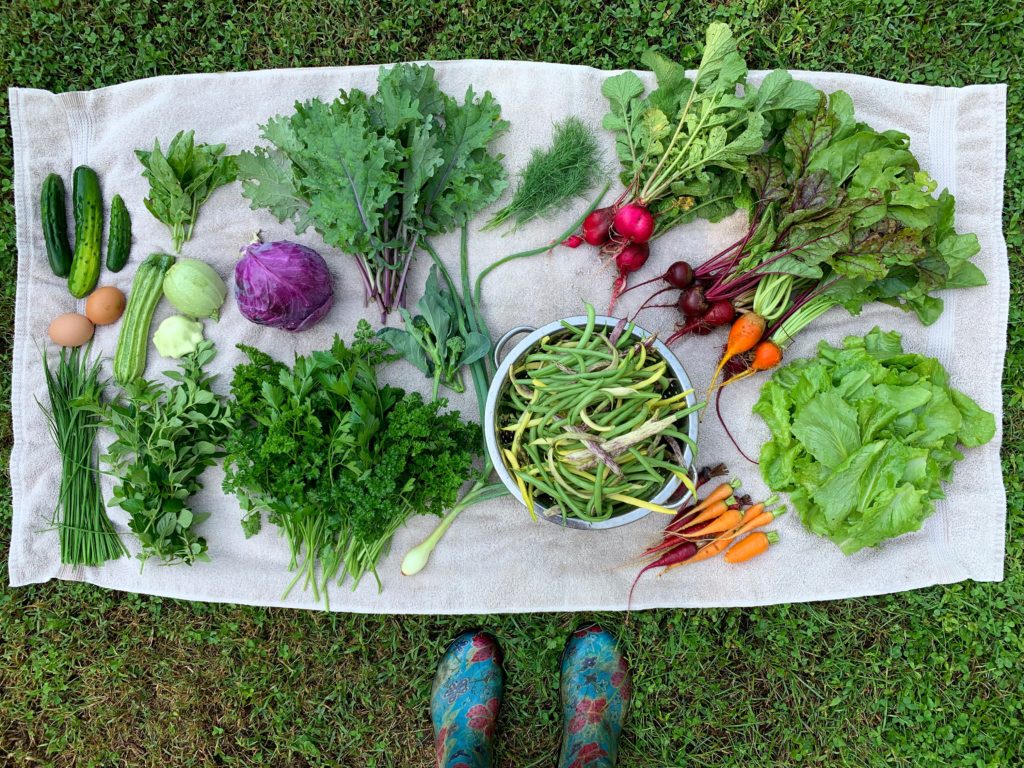
A sample of my summer garden harvest, a testament of the benefits of cover crops.
When I first started landscaping almost two decades ago, I’d occasionally come across buried fabric in garden beds known as landscape fabric. I’ve also heard it called “weed barrier” or “weed fabric”, but the idea is that you place the permeable fabric directly on top of the soil, cut holes where plants are to be placed, and then cover the entire thing with mulch to block weeds from growing in your garden beds. I used it sparingly in those early years of landscaping when I honestly had no idea what I was doing, but I moved before I had the opportunity to see how those gardens (and the landscape fabric) performed overtime.
I decided to try my own landscape fabric experiment at my house and see how truly magical this stuff can be over a long period of time. I bought the heaviest weight available from Lowe’s and placed it in garden walkways, fence borders (I lined both sides of my garden fence with mulch to help keep weeds from growing through the fence), and around my blueberries. Four years later, I can say without a doubt that landscape fabric has some great applications, but mostly falls short of expectations.
Why Landscaping Fabric Isn’t a Long Term Solution
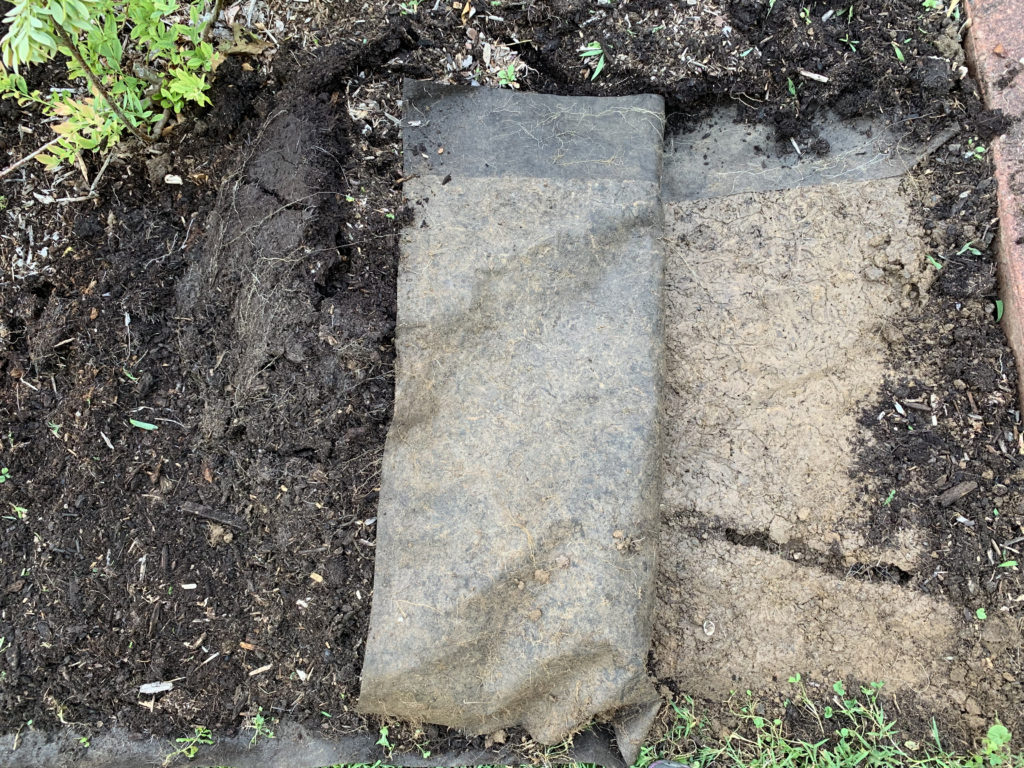
You can clearly see the compacted soil below the landscape fabric and the organic matter above.
Before I begin, I should be clear in that my blueberries are not thriving. I placed landscape fabric around the bushes when they were planted almost four years ago and they’ve never looked great. A few are starting to finally look established, but the majority look puny and a bit N-deprived. Some of the issue with the berries is related to pests, specifically, squirrels that are really aggressive with the bushes and fairly destructive, but there’s clearly a nutrient problem, too. The nutrient issue is what persuaded me to remove the landscape fabric and start a soil remediation project.
What I immediately learned is that the biggest issue with landscape fabric is that it creates a physical barrier between the top organic layer and the subsoil. Mulch, dried leaves, and other dead plant materials decompose at the soil surface to create what is known as the O (organic) horizon, the uppermost layer of soil that is richest in carbon, nutrients, and organic matter. Plant roots grow through these layers, creating tunnels, cavities, and pressure that encourage the movement of substances from these upper layers into lower depths. The growth of roots through the soil ultimately helps to mix the soil profile and bring nutrients below where they can be distributed, stored, and put to use, while also drawing minerals up. This action is further accelerated by soil invertebrates – organisms like worms, nematodes, and arthropods that spend their lives burrowing through the soil, creating pathways for the movement of nutrients, organic matter, and water. When using landscape fabric, the uppermost soil layer (the O horizon) that’s most nutrient rich, becomes inaccessible to invertebrates and misses out on the important action of plant roots.
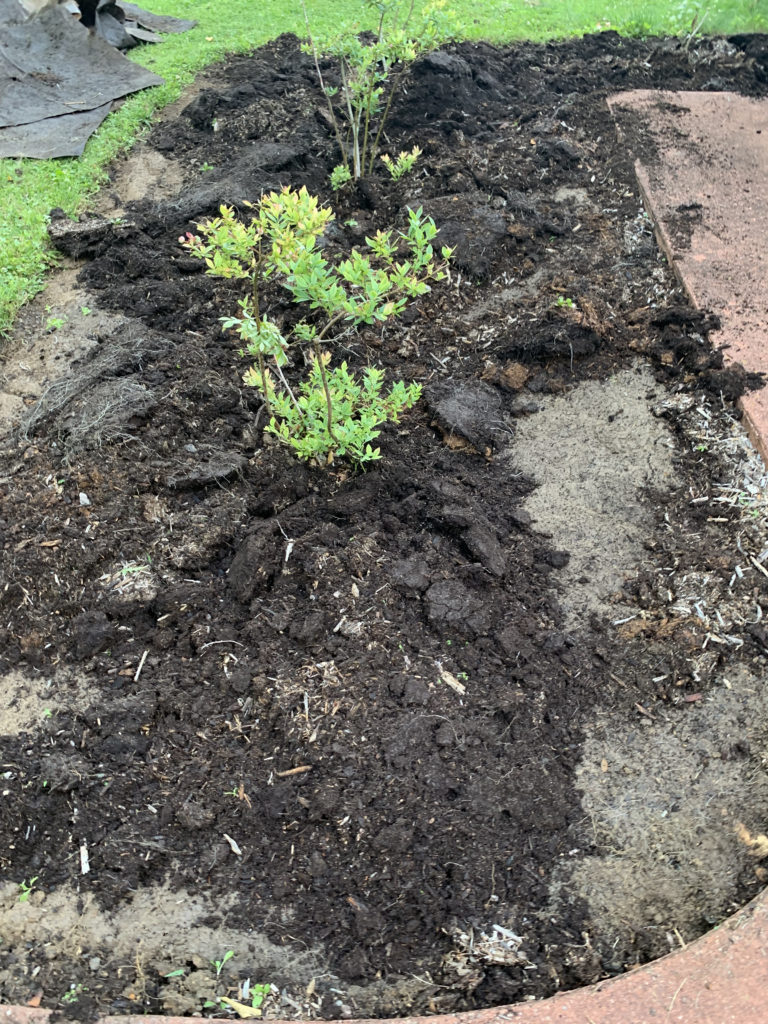
After landscape fabric removal, the two layers of soil were clearly distinct.
When I removed the landscape fabric from around my blueberries I found a solid, compacted layer below the landscape fabric with an ample amount of organic matter above the fabric. The two layers had clearly failed to intermingle meaning that the rich organic material was inaccessible to the soil organisms, thus the roots of my blueberry bushes. Put bluntly, this was not good.
Some of my other observations where that the soil below the landscape fabric had become even more compacted than when the fabric was initially placed. This was a sign that there was poor aeration, as well. I saw very few, if any, invertebrates living within either layer of soil (above or below the landscape fabric), indicating that this system wasn’t conducive for life. My philosophy when it comes to gardening is that you’re never feeding your plants, you’re always feeding your soil. The use of landscape fabric doesn’t allow for proper soil feeding.
Blueberry Bush Soil Remediation: Compost and Cover Crops
Needless to say, I removed every last bit of landscape fabric from around my blueberries after discovering that the system was failing. I then smoothed out the mulch and organic matter that previously existed on top of the fabric and used my broadfork to loosen and aerate the entire bed. Keep in mind that I NEVER turn my soil. A broadfork is used for aeration, not for digging and turning. The spikes move deeply into the soil and the handles are simply tipped to the point where you can see the soil crack and move, which allows air and organic matter to slip into these cracks. Most people would have been tempted to dig and break apart all of that clay, but this would only destroy soil structure, aggregation, and the natural processes that will overtime maximize the health of this soil.
I next spread a thin layer of composted leaves on top. The amount of compost was inadequate, so I later bought 1.5 yards of mushroom compost from our local landscape supply company. My plan was to cover the entire bed with red clover, a cover crop that has a deep tap root and the ability to fix nitrogen, but I was out of clover seeds. I instead used a cover crop mix of oat and field peas. I bought this mix when it was on sale last year and this is the first time I’ve had the opportunity to use it. While I’m a little disappointed that I didn’t have my trusted clover, I’m hoping that this mix will yield equally as beneficial results. Oats are a type of grass, which are notorious for their ability to move carbon into the soil. And in short, more carbon = more organic matter = better nutrient and water holding capacity. The field peas, like clover, are a legume which are well-known nitrogen fixers and help feed a healthy bacterial population in the soil through the use of carbon-based exudates and fungal “communication”. I won’t go into too much detail other than to say that more life in the soil means more nutrients and better structure. So using cover crops to prime the soil will result in greater soil biodiversity and healthier blueberry bushes overtime.
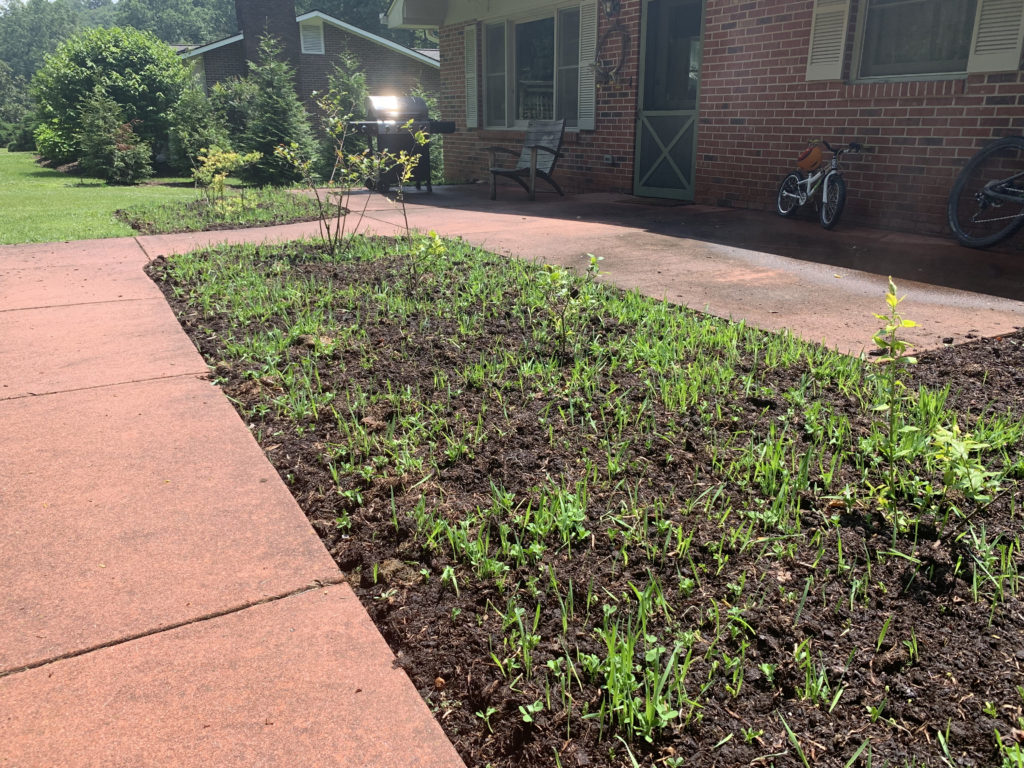
The oat and field pea mixture is already growing.
My plan is to keep the oat and field pea mix alive as long as possible. I’ll likely mow it down to about 8″ a few times over the course of the summer using a weed eater, but I don’t know how this particular mix responds to trimming, so it’ll be a bit of an experiment. Cutting it too short will result in accidentally killing the plant entirely, and temperatures may cause the plants to die, regardless. I’m honestly not too concerned with the outcome since my plan is to continually plant cover crops on this area for the next little bit as the soil slowly recovers. I’ve found that clover is easier to keep short when compared to other cover crops, which is why I wanted to use clover in the first place (clover is my first and only choice for living mulches, although I’m guessing that vetch would work the same. Keep in mind that vetch isn’t as easily removed due to its delicate nature and difficulty to weed, if necessary). My focus for improving the soil is to continue to grow plants on the soil (cover crops and others) in order to breathe life back into it.
Landscape Fabric Benefits
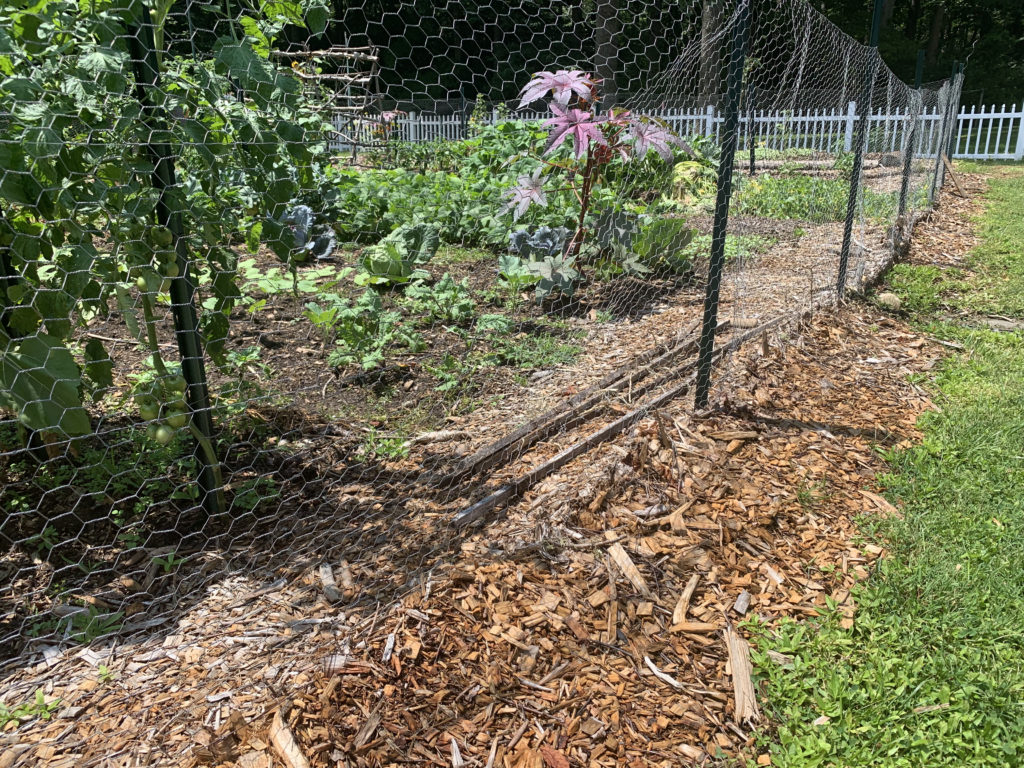
You can see that my fence is mulched on both sides to prevent weeds from growing into the fence. A layer of landscape fabric makes this border easy to maintain.
Hopefully I’ve made it clear that landscape fabric isn’t a great choice for garden beds, but I have been quite please with its use in permanent walkways and as the barrier around my fence. The reason for this is because weeds start to grow up and over the edges of my mulch around the fence and they have to be taken back every couple of years or so as to keep my borders neat and defined. I can simply pull up the fabric, remove the weeds from the top, return the fabric to its original position, and then cover it with fresh mulch. I also removed the composted layer from the top of the fabric and spread it in my garden beds (I mean, it wasn’t much, but every bit helps).
I also used landscape fabric in a 4′ wide walkway in my garden and on one side of my berry trellis. It seems to have worked particularly well for these applications since the soil is likely compacted underneath and is inhospitable for plant growth. I have very few weeds that pop up in this mulched area. It has also helped to keep the blackberry runners from making their way into areas where I’d prefer they not dwell. I’ve used cardboard is some spots since I didn’t have enough landscape fabric and honestly, cardboard works almost as well, but you really have to be sure to lay the cardboard layers down thick and overlap as to prevent weeds from making their way through. The trick is finding large pieces of cardboard, which can be accomplished by collecting bike or appliance boxes from local retailers, if available.
The one fallback I see is that I’ll continue to mulch my pathways from time to time which means that a thicker and thicker layer of organic matter is going to be accumulating on top of the landscape fabric. Overtime, the fabric will be buried, and its removal will be become nearly impossible. At this stage, the top organic layer will likely be hospitable for plant growth, meaning that the function of the fabric is completely lost.
In Summary
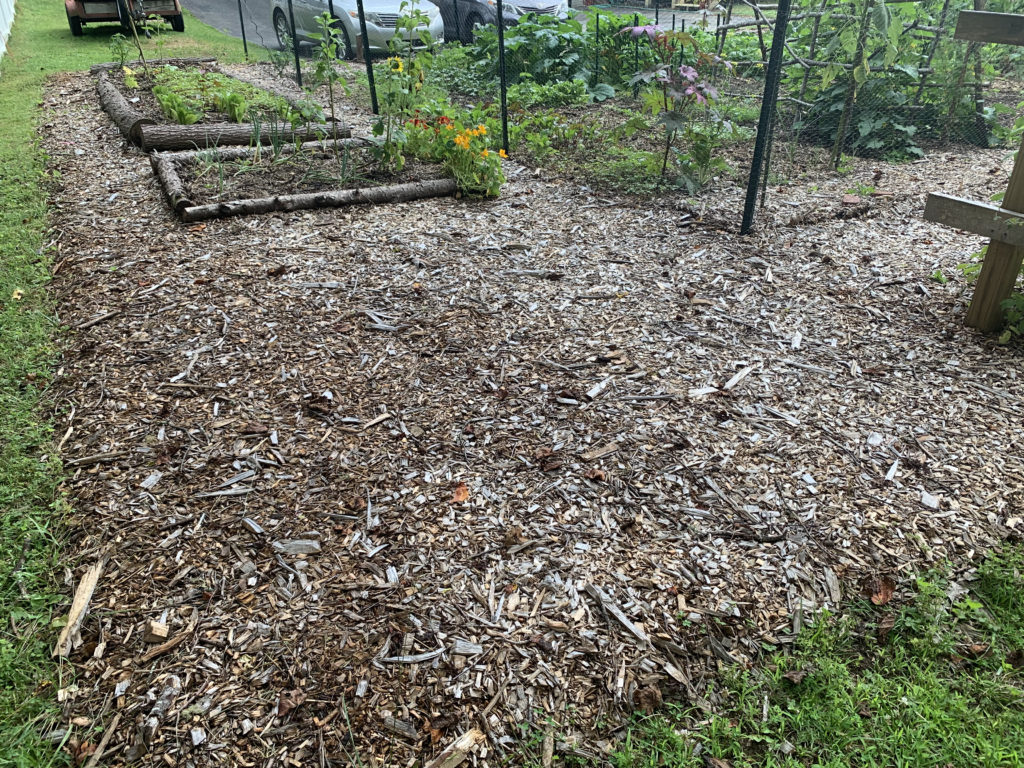
These pathways and the raised beds were started by smothering the grass with thick, overlapping layers of cardboard that were then covered in wood chips. The raised beds were then filled with more wood chips and compost, and were recently planted with a cover crop to improve soil structure.
If given the chance to do it again, I’d choose the cardboard for garden paths and mulching around berry bushes or plants. I don’t see a particular long term benefit to using the fabric in either of these spots. In fact, the fabric has caused more harm than good where my blueberries are planted. However, I may keep using landscape fabric when creating mulched borders under fencing. I can easily maintain these borders by peeling up the fabric, removing the weeds and organic matter, replacing the fabric, and applying more mulch.
I also want to use this opportunity to remind people of the benefits that cover crops offer. Traditional gardening and farming methods encourage tillage and fertilizer application, but the focus is shifting in that growers are learning to use natural processes to improve their soil. My choice to avoid tilling and turning at all costs has actually resulted in far less work, a practice that I think we can all agree is desirable. But, it’s an approach that takes a bit more patience since you’ll have to work with nature rather than against it.
I hope you enjoyed reading this post and that you found it useful in thinking about how to manage your own (or future) garden beds. Let me know if you have anything to add!
Leave a Reply